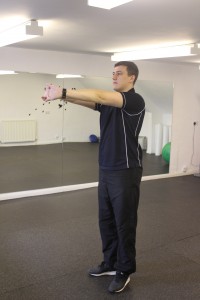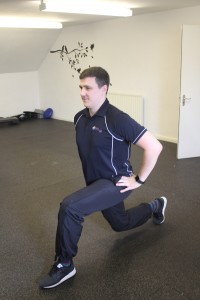Static stretching has been found beneficial for overall flexibility, which can help lengthen your stride, thereby improving your running time. However, there has been a lot of controversy lately over the adverse effects of static stretching possibly reducing muscle contraction speed and therefore impairing runners and other athletes.
A static stretch means placing a certain muscle or muscle group in a position where it can be extended for a certain amount of time. As part of a warm-up routine, the stretch can be held for as short as 10 seconds. Each muscle or muscle group needs to be stretched only one time. When applying a stretch, make sure the body is in balance.
Slowly lean into the stretch, paying attention to the sensations in that particular muscle group. You should feel a stretch but it should not hurt. Do not bounce or make ‘jerking’ movements while stretching, this might result in the opposite effect, such as a muscle tensing up to protect itself from being extended too far (the stretch reflex).
Aim to relax more into the stretch as you breathe out. As you do stretching exercises more often, you will become more familiar with how your body feels, you might notice that muscle tense up a little while breathing in before relaxing again on the out breath. This knowledge might become useful as you increase your long runs where body parts such as the shoulders become increasingly tense.
Static Stretching After Running
A static stretching routine after your training run or distance race should be a fixed part of the whole physical activity after a cool down period. Aim to hold each stretch for a minimum of 20-30 seconds, breathe comfortably, with deep breaths in through your nose, and out through your mouth. Static stretches help muscles to relax, realigning muscle fibres and re-establishing normal range of movement.
Static Stretching Drills
Stretches which are strongly suggested to be performed after running during cool down: Upper Back Stretch, Shoulder Stretch, (standing) Hamstring Stretch, Calf Stretch, Hip and Thigh Stretch, Adductor Stretch, Standing Iliotibial Band Stretch, Standing Shin Stretch.
1) UPPER BACK STRETCH
 Stand tall, feet slightly wider than shoulder-width apart, knees slightly bent. Interlock your fingers and push your hands as far away from your chest as possible, allowing your upper back to relax. You should feel the stretch between your shoulder blades.
Stand tall, feet slightly wider than shoulder-width apart, knees slightly bent. Interlock your fingers and push your hands as far away from your chest as possible, allowing your upper back to relax. You should feel the stretch between your shoulder blades.
2) SHOULDER STRETCH
 Stand tall, feet slightly wider than shoulder-width apart, knees slightly bent. Place your right arm, parallel with the ground across the front of your chest. Bend the left arm up and use the left forearm to ease the right arm closer to your chest. You will feel the stretch in the shoulder. Repeat with the alternative arm.
Stand tall, feet slightly wider than shoulder-width apart, knees slightly bent. Place your right arm, parallel with the ground across the front of your chest. Bend the left arm up and use the left forearm to ease the right arm closer to your chest. You will feel the stretch in the shoulder. Repeat with the alternative arm.
3) HAMSTRING STRETCH
 Sit on the ground with both legs straight out in front of you, bend the left leg and place the sole of the left foot alongside the knee of the right leg. Allow the left leg to lie relaxed on the ground, bend forward keeping the back straight. You will feel the stretch in the hamstring of the right leg. Repeat with the other leg.
Sit on the ground with both legs straight out in front of you, bend the left leg and place the sole of the left foot alongside the knee of the right leg. Allow the left leg to lie relaxed on the ground, bend forward keeping the back straight. You will feel the stretch in the hamstring of the right leg. Repeat with the other leg.
4) STANDING HAMSTRING STRETCH
 Stand with your left leg one step in front of your right foot, bend your right knee and sit your weight on it. Toes of your front foot point up to the sky, with hands folded on the thigh. Tilt the hips forwards as if sticking your bum in the air, keeping your back straight, hold when you feel a comfortable stretch. Repeat with the other leg.
Stand with your left leg one step in front of your right foot, bend your right knee and sit your weight on it. Toes of your front foot point up to the sky, with hands folded on the thigh. Tilt the hips forwards as if sticking your bum in the air, keeping your back straight, hold when you feel a comfortable stretch. Repeat with the other leg.
5) CALF STRETCH
 Stand tall with one leg in front of the other, hands flat and at shoulder height against a wall. Ease your back leg further away from the wall, keeping it straight and press the heel firmly into the floor. Keep your hips facing the wall and the rear leg and spine in a straight line. You will feel the stretch in the calf of the rear leg. Hold the stretch and then repeat with the other leg.
Stand tall with one leg in front of the other, hands flat and at shoulder height against a wall. Ease your back leg further away from the wall, keeping it straight and press the heel firmly into the floor. Keep your hips facing the wall and the rear leg and spine in a straight line. You will feel the stretch in the calf of the rear leg. Hold the stretch and then repeat with the other leg.
6) HIP AND THIGH STRETCH
 Stand tall with your feet approximately two shoulder widths apart. Turn the feet and face to the right. Bend the right leg so that the right thigh is parallel with the ground and the right lower leg is vertical. Gradually lower the body keeping your back straight and use the arms to balance. You will feel the stretch along the front of the left thigh and along the hamstrings of the right leg. Hold a comfortable stretch and repeat by turning and facing to the left.
Stand tall with your feet approximately two shoulder widths apart. Turn the feet and face to the right. Bend the right leg so that the right thigh is parallel with the ground and the right lower leg is vertical. Gradually lower the body keeping your back straight and use the arms to balance. You will feel the stretch along the front of the left thigh and along the hamstrings of the right leg. Hold a comfortable stretch and repeat by turning and facing to the left.
7) ADDUCTOR STRETCH
 Stand tall with your feet approximately two shoulder widths apart, bend the right leg and slowly lower the body keeping your back straight and use the arms to balance. You will feel the stretch in the left leg adductor. Hold the stretch just before pain level and repeat with the left leg.
Stand tall with your feet approximately two shoulder widths apart, bend the right leg and slowly lower the body keeping your back straight and use the arms to balance. You will feel the stretch in the left leg adductor. Hold the stretch just before pain level and repeat with the left leg.
8) STANDING ILOPTOBIAL BAND STRETCH
 Cross one leg in front of the other leg, bend down and touch your toes, move your hands across the floor toward the front leg to put more stretch on the outside of your thigh on the other side. Repeat with the other leg.
Cross one leg in front of the other leg, bend down and touch your toes, move your hands across the floor toward the front leg to put more stretch on the outside of your thigh on the other side. Repeat with the other leg.
9) QUADRICEPS STRETCH
 Stand tall holding or leaning to an object to keep your balance. Grasp the top of your ankle or forefoot behind you and pull ankle toward the buttocks. Repeat with the opposite leg.
Stand tall holding or leaning to an object to keep your balance. Grasp the top of your ankle or forefoot behind you and pull ankle toward the buttocks. Repeat with the opposite leg.
10) STANDING SHIN STRETCH
 Stand tall holding or leaning to an object to keep your balance. Grasp your forefoot behind you. Pull your forefoot toward your lower back and look forward. Hold stretch at a comfortable level and repeat with your other leg.
Stand tall holding or leaning to an object to keep your balance. Grasp your forefoot behind you. Pull your forefoot toward your lower back and look forward. Hold stretch at a comfortable level and repeat with your other leg.

